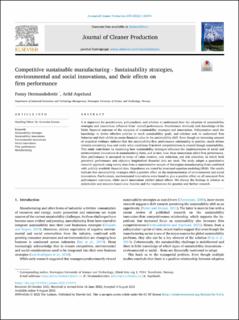| dc.contributor.author | Hermundsdottir, Fanny | |
| dc.contributor.author | Aspelund, Arild | |
| dc.date.accessioned | 2022-12-07T12:53:32Z | |
| dc.date.available | 2022-12-07T12:53:32Z | |
| dc.date.created | 2022-09-05T14:02:57Z | |
| dc.date.issued | 2022 | |
| dc.identifier.issn | 0959-6526 | |
| dc.identifier.uri | https://hdl.handle.net/11250/3036367 | |
| dc.description.abstract | It is important for practitioners, policymakers, and scholars to understand how the adoption of sustainability strategies and innovations influence firms’ overall performance. Practitioners obviously seek knowledge of the likely financial outcome of the adoption of sustainability strategies and innovations. Policymakers need the knowledge to devise effective policies to reach sustainability goals, and scholars seek to understand firm behavior and their ability to create financial value in the sustainability shift. Even though an increasing amount of empirical evidence indicate that the sustainability-firm performance relationship is positive, much debate remains concerning how and under what conditions firm-level competitiveness is created though sustainability. This study contributes by examining how sustainability strategies influence the implementation of social and environmental innovations in manufacturing firms, and in turn, how these innovations affect firm performance. Firm performance is measured in terms of value creation, cost reduction, and risk reduction, in which both perceived performance and objective longitudinal financial data are used. The study adopts a quantitative research approach using survey data from a representative sample of Norwegian manufacturing firms combined with publicly available financial data. Hypotheses are tested by structural equation modeling (SEM). The results indicate that sustainability strategies elicit a positive effect on the implementation of environmental and social innovations. Furthermore, environmental innovations were found to give a positive effect on all measured firm performance outcomes, while social innovations yielded mixed effects. We discuss the findings in relation to stakeholder and resource-based-view theories and the implications for practice and further research. | en_US |
| dc.language.iso | eng | en_US |
| dc.publisher | Elsevier Science | en_US |
| dc.rights | Navngivelse 4.0 Internasjonal | * |
| dc.rights.uri | http://creativecommons.org/licenses/by/4.0/deed.no | * |
| dc.title | Competitive sustainable manufacturing - Sustainability strategies, environmental and social innovations, and their effects on firm performance | en_US |
| dc.title.alternative | Competitive sustainable manufacturing - Sustainability strategies, environmental and social innovations, and their effects on firm performance | en_US |
| dc.type | Peer reviewed | en_US |
| dc.type | Journal article | en_US |
| dc.description.version | publishedVersion | en_US |
| dc.source.volume | 370 | en_US |
| dc.source.journal | Journal of Cleaner Production | en_US |
| dc.identifier.doi | https://doi.org/10.1016/j.jclepro.2022.133474 | |
| dc.identifier.cristin | 2048909 | |
| cristin.ispublished | true | |
| cristin.fulltext | original | |
| cristin.qualitycode | 2 | |

